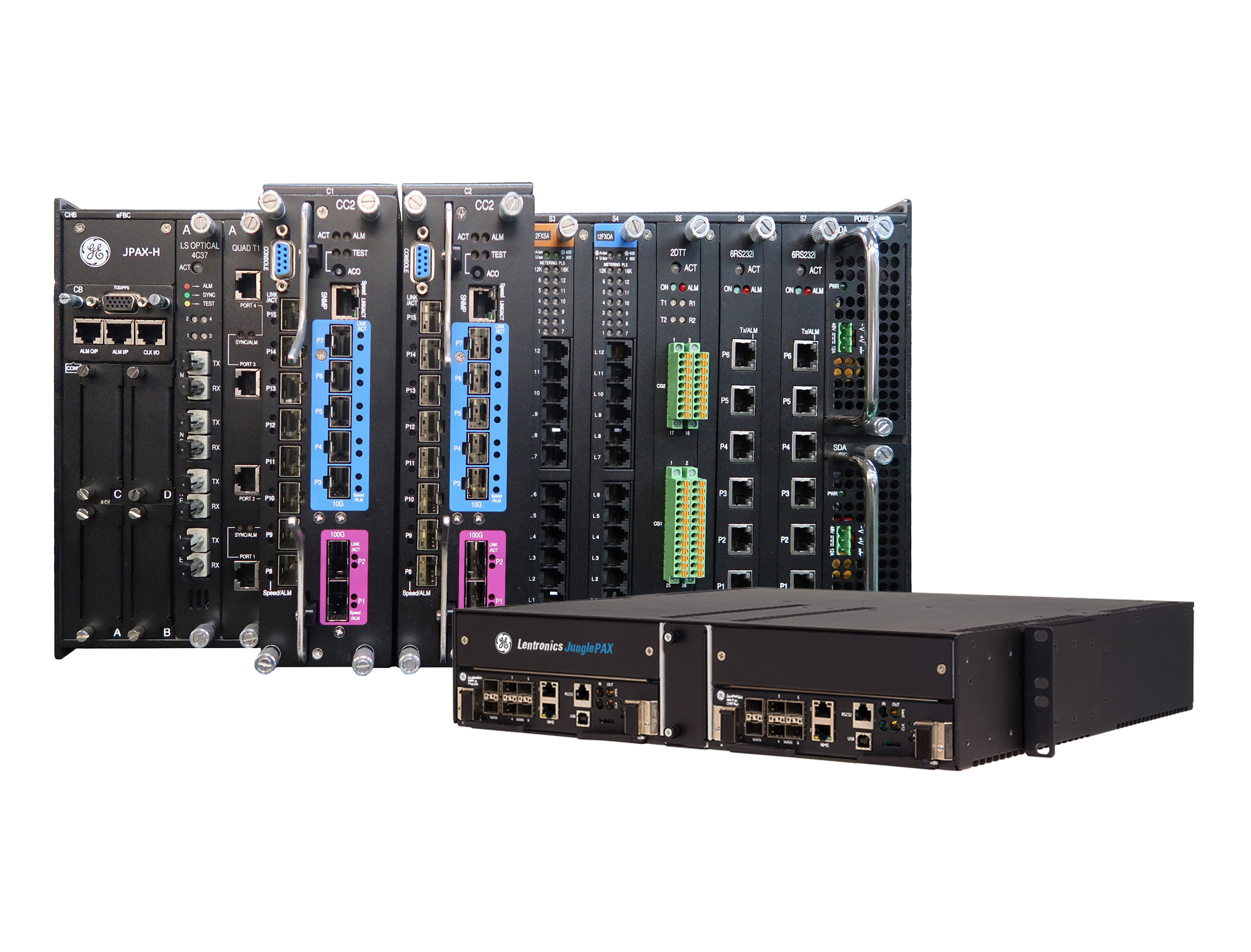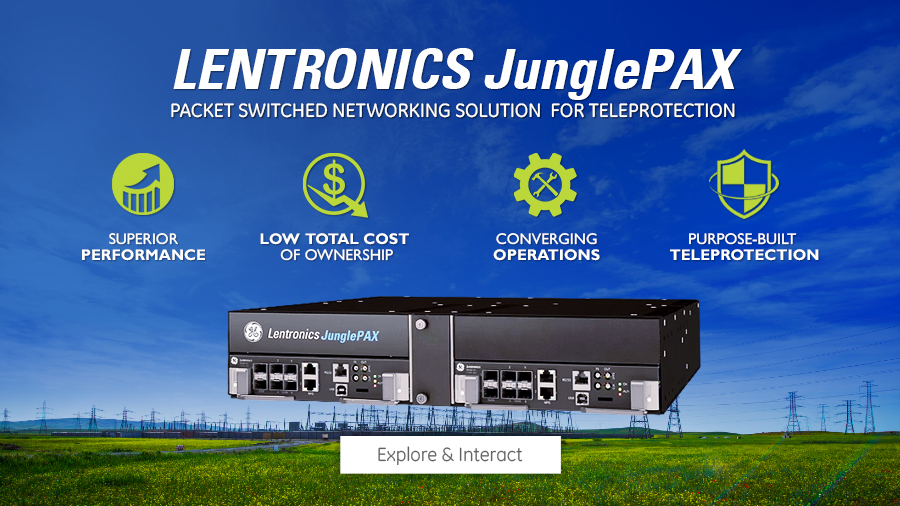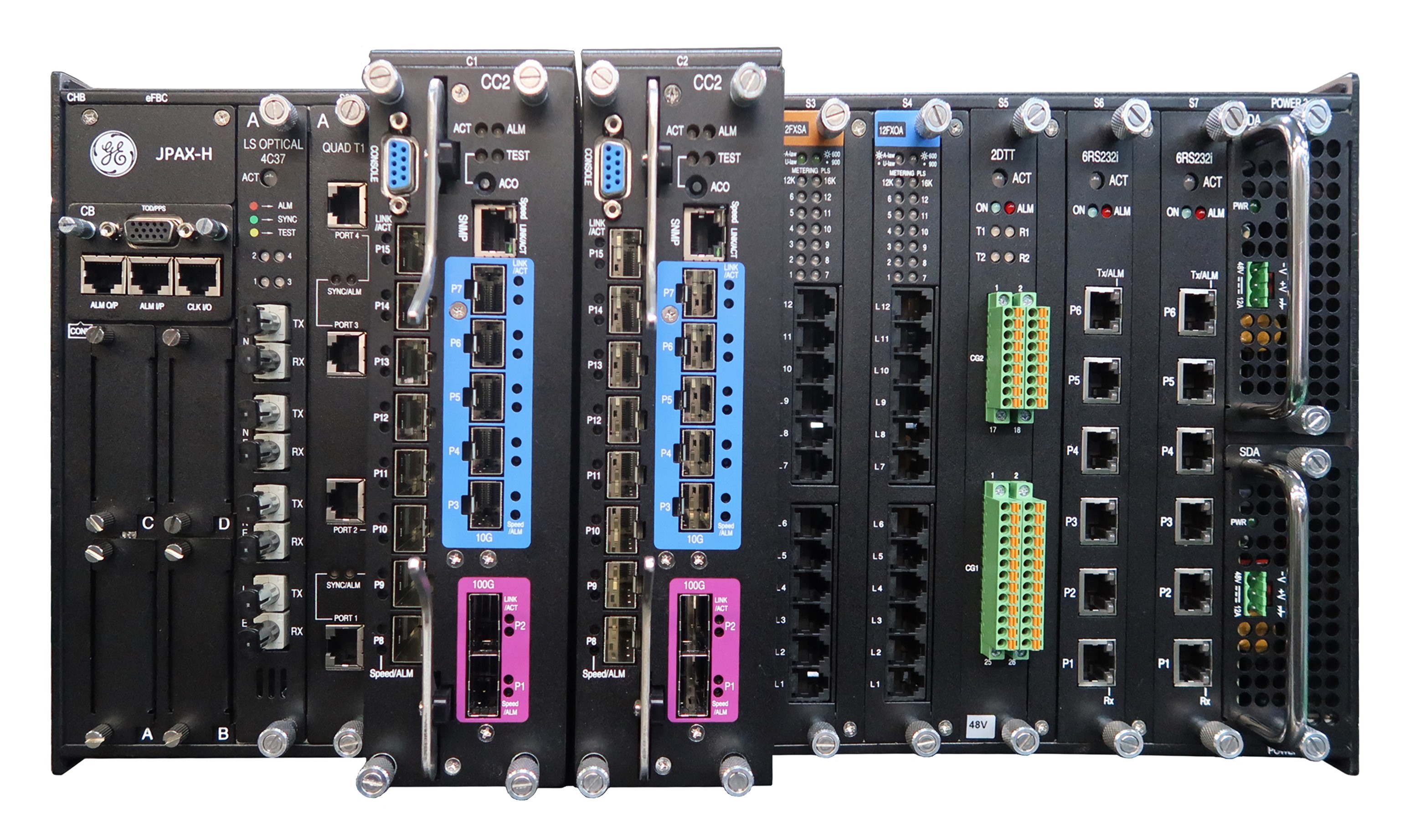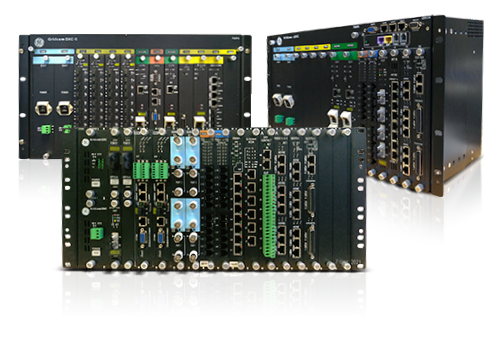JPAX family
Packet-Switched Networking Solution for Teleprotection with Hybrid+ Transport Capabilities
JPAX family is a purpose-built communications solution specifically designed for utility operations, providing the required security and dependability through layers of redundancy. The platform is based on MPLS-TP (Multi-protocol Label Switching with Transport Profile) technology that maintains deterministic performance through packet based communications providing utilities with increased efficiency and ease of integration.
The JunglePAX platform employs an optimized version of MPLS-TP coupled with a SONET/SDH-transport layer to produce a converged communications platform to reliably transport 64 kbps, T1/E1 TDM and Ethernet services across an optical Wide-Area Network (WAN). With a flexible mix of WAN connectivity, access options, and with hardware redundancy on critical modules and control functions, the JunglePAX provide utilities a cost effective, single streamlined solution to better protect energy assets and improve system reliability.
Key Benefits
- Improve service quality with a secure and dependable platform that provides reliable communications for utility applications within harsh industrial environments.
- Maximize service uptime using specially designed hardware to ensure utility-grade performance through layers of redundancy. Address emerging applications by implementing a flexible and scalable solution to assist with network convergence where traffic and application mix change.
- Improve system-wide manageability with integrated and application-driven software that simplifies network management. Increase control and promote information assurance with an advanced cybersecurity platform that employs defense-in-depth strategies.
JPAX family
Packet-Switched Networking Solution for Teleprotection with Hybrid+ Transport Capabilities
JPAX family is a purpose-built communications solution specifically designed for utility operations, providing the required security and dependability through layers of redundancy. The platform is based on MPLS-TP (Multi-protocol Label Switching with Transport Profile) technology that maintains deterministic performance through packet based communications providing utilities with increased efficiency and ease of integration.
The JunglePAX platform employs an optimized version of MPLS-TP coupled with a SONET/SDH-transport layer to produce a converged communications platform to reliably transport 64 kbps, T1/E1 TDM and Ethernet services across an optical Wide-Area Network (WAN). With a flexible mix of WAN connectivity, access options, and with hardware redundancy on critical modules and control functions, the JunglePAX provide utilities a cost effective, single streamlined solution to better protect energy assets and improve system reliability.
Key Benefits
- Improve service quality with a secure and dependable platform that provides reliable communications for utility applications within harsh industrial environments.
- Maximize service uptime using specially designed hardware to ensure utility-grade performance through layers of redundancy. Address emerging applications by implementing a flexible and scalable solution to assist with network convergence where traffic and application mix change.
- Improve system-wide manageability with integrated and application-driven software that simplifies network management. Increase control and promote information assurance with an advanced cybersecurity platform that employs defense-in-depth strategies.
JunglePAX WAN ports supports standard MPLS
Both JunglePAX 10G WAN ports (1 & 2) now optionally support standard MPLS mode in addition to Hybrid mode as a user configurable option. Additionally, two out of four 1G WAN ports (4 & 6) now operate in standard MPLS mode (not user-configurable).
Use of standard MPLS mode allows for interoperability with foreign MPLS equipment and Ethernet microwave radio devices. Note that foreign MPLS and Ethernet radio devices generally don’t support the IEEE 802.3ae standard, which is used by JunglePAX as a basis for hybrid mode implementation. The 1G WAN ports 3 and 5 continue to support Hybrid mode only. Use of Hybrid mode continues to be advantageous in standalone JPAX network applications as it allows native, non-packetized TDM services and MPLS services to coexist on the same fiber.
The WAN ports in standard MPLS mode allows for tunneling JunglePAX NMS information through foreign packet-based devices/networks to ensure that all JunglePAX nodes are visible regardless of whether they are optically connected to each other or via foreign packet-based devices/network.
 JunglePAX WAN ports support standard MPLS
JunglePAX WAN ports support standard MPLS
Native TDM and TDM over Packet: xTDM offers the best of both worlds
Introducing the xTDM Access Card for the JunglePAX Hybrid Packet & TDM platform that offers the best of both worlds. This add-on unit offers the flexibility to support both native TDM over Hybrid WAN ports as well as emulated T1/E1 signals over MPLS, making it extremely flexible for all customer applications.
This release also allows for establishing packetized point-to-point Nx64k services between xTDM-8A cards T, or T1E1-4A/CBUS-4A ports at the far end. Point-to-point Nx64k services between local xTDM-8A card and JIF-Share/CMUX/CDAX card residing at remote JMUX/TN1U/TN1Ue nodes are also supported via Evolution units.
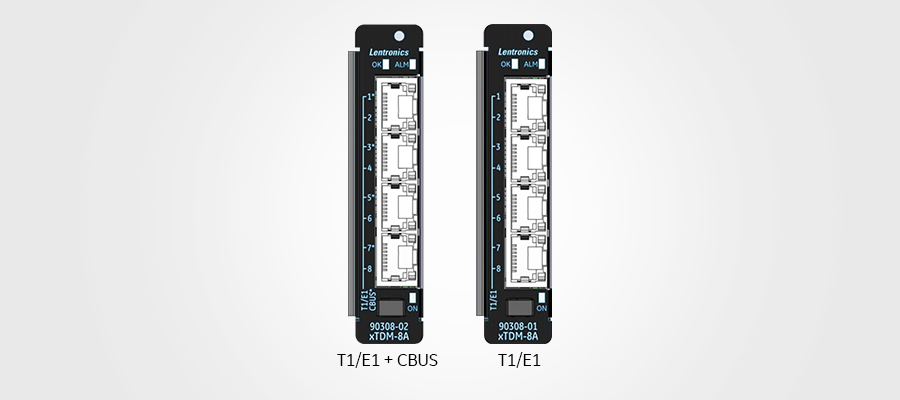
The xTDM Access Card key features:
- Up to 8 x bulk T1E1 services or up to 4 x CBUS ports (via future 90308-02 card)
- Two ports per each RJ-45 connector, requiring the use of splitter cables to gain access to the even numbered ports
- Supports transport of bulk T1/E1 over MPLS or SONET/SDH
- Supports transport of Nx64kbps services over MPLS
- Future supports for 1+1 redundant hardware configuration if two cards are installed in adjacent slots
- Services can be established to existing T1E1-4A units
Evolution Module - Optically connecting JMUX and JPAX for simplified interoperability
GE Vernova’s new Evolution Module (B86900-01) enables migration to MPLS ring-by-ring or node-by-node AND offering an upgrade opportunity to modernize hardware while preserving highly dependable SONET/SDH delay performance for critical services through deployment of JunglePAX Hybrid Mode. Evolution and Hybrid work together to ensure ongoing security and dependability across both SONET/SDH and MPLS planes.
1 Gigabit of Ethernet data can now be passed over the same 1G+ fiber link as SONET VT1.5 or SDH TU-1’s to enable full interoperability between JMUX/TN1U and JPAX.
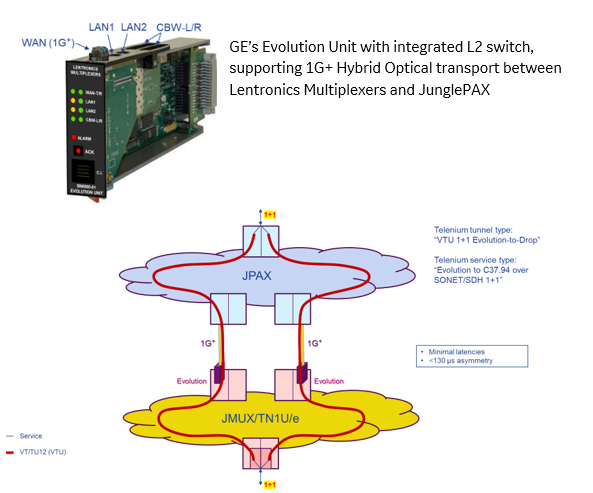 Tying Lentronics Multiplexer and JunglePAX networks together via dual-home Evolution Modules. Showing TDM services that bypass packetization to create end-to-end TDM services with SONET/SDH equivalent performance
Tying Lentronics Multiplexer and JunglePAX networks together via dual-home Evolution Modules. Showing TDM services that bypass packetization to create end-to-end TDM services with SONET/SDH equivalent performance
Advanced Network Management System for JPAX
GE Vernova's EnerVista INSIGHT Advanced NMS solution employs Smart Tile technology, replacing the existing Telenium Traffic Manager, to assist users build MPLS Tunnels, SONET/SDH VTU’s and Services. This approach employs a wizard-based engine that walks users through each of the unique build processes using a combination of maps, graphical services tools and optimizers to quickly achieve their desired outcomes.
Schedule a demonstration today to see the new GE Vernova EnerVista INSIGHT version 8.8.
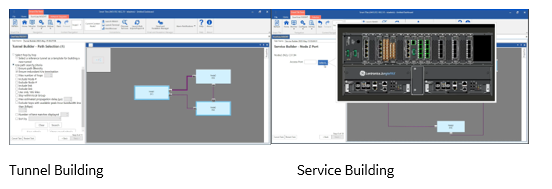 EnerVista 8.8
EnerVista 8.8
WAN Encryption for improved confidentiality
Encryption of all MPLS traffic carried over the WAN is now supported. This is a licensed feature, allowing users to encrypt individual fiber optic segments on any of the 12 WAN JunglePAX ports. After enabling Encryption on both sides of a WAN link, public/private keys will automatically roll based on the administrator’s configuration (30 min to 200 hrs), or keys can be manually renewed on each segment via the Web User Interface.
Purpose-Built for Teleprotection and Superior Performance
- High speed protection switching within 3ms
- Low end-to-end service latency within <1ms over SONET/SDH transport layers
- Designed with layers of redundancy for improved security and dependability
- ‘AAA’ secured and encryption for improved reliability
Single Solution Converging and Simplifying Operations
- Flexible design for deployment across backhaul, aggregation and access networks
- One box solution for mission critical OT and IT, capable of connecting multiple and diverse applications
- Integrated and application-driven software simplifies network management
- Network-wide Summary and Status Information dashboard for simplified health and integrity validation
Ruggedized with modular design lowering total cost of ownership
- Industrially hardened with no cooling fans for longer life in harsh environments
- Offers integrated application-specific access modules designed for critical production relaying applications
- Certified to IEEE 1613 and IEC 61850-3 substation hardening requirements
- Processes 24 Gb/s of traffic across the extended -20°C to + 60°C operating temperature
- Flexible redistribution of service ports
JunglePAX Overview
The JunglePAX platform is designed for utilities with critical utility communications in mind. GE Vernova’s JPAX offers a truly converged solution with security and dependability for all applications whether they are critical Teleprotection circuits or for less time-sensitive business IT needs. Security and Dependability ensure data will be delivered and received on time when an actual data packet is sent, and data will not be falsely received when no data was sent. Both are key performance requirements to ensure utility communications reliably operate at all times. JunglePAX equipment is
- Purpose built for teleprotection and superior performance
- Single solution converging and simplifying operations
- Ruggedized and Modular Design Lowering Total Cost of Ownership
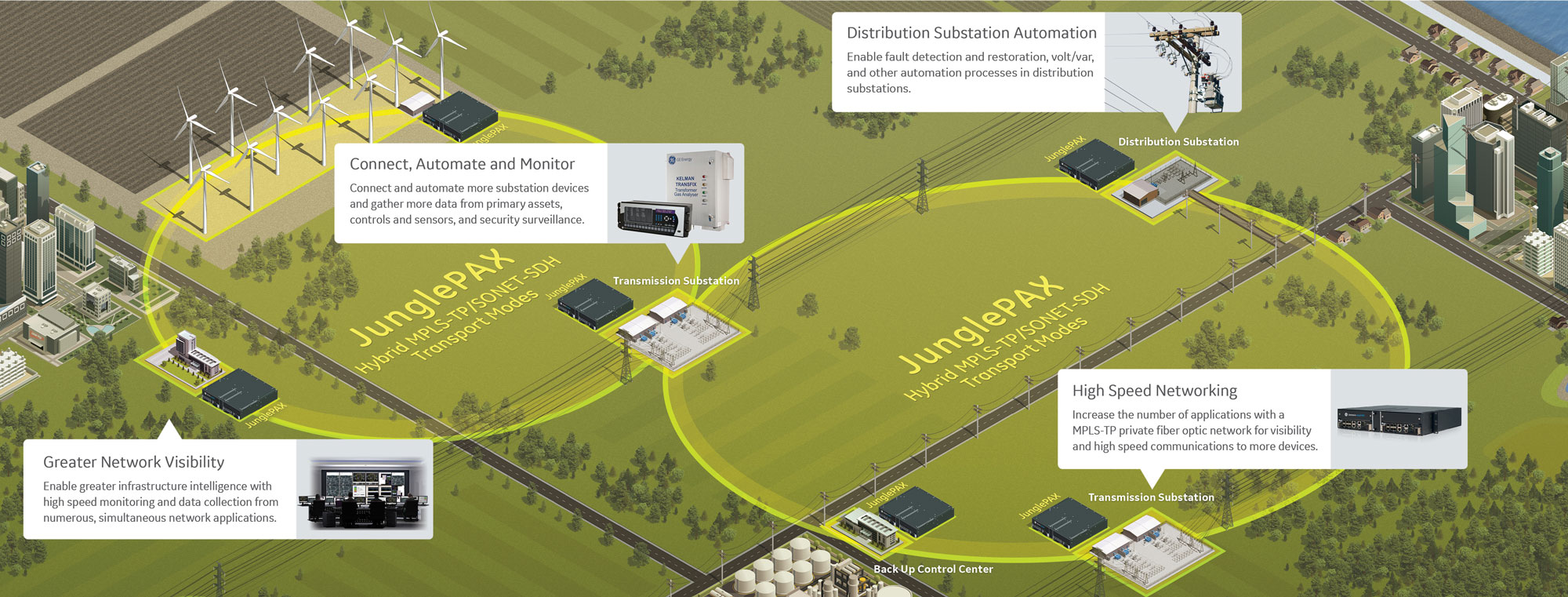 The JunglePAX solution can be applied to the overall power infrastructure from the Core (Backhaul) network to Aggregation and Access Networks, providing an application-defined approach to utility networking that assures service quality, security and perfo
The JunglePAX solution can be applied to the overall power infrastructure from the Core (Backhaul) network to Aggregation and Access Networks, providing an application-defined approach to utility networking that assures service quality, security and perfo
Hybrid+ Mode, for critical teleprotection where 1ms latency is too slow
JunglePAX Hybrid+ technology offers the best of both worlds by preserving SONET/SDH performance in a packet-switched network. This is achieved by adding an independent SONET/SDH layer alongside the MPLS-TP layer (without impacting its capacity) over the same optical WAN link. Use of this layer is optional and is intended for TDM-based relaying applications (C37.94, RS-232 Mirrored Bit, G.703 64k etc.) that are extremely delay sensitive.
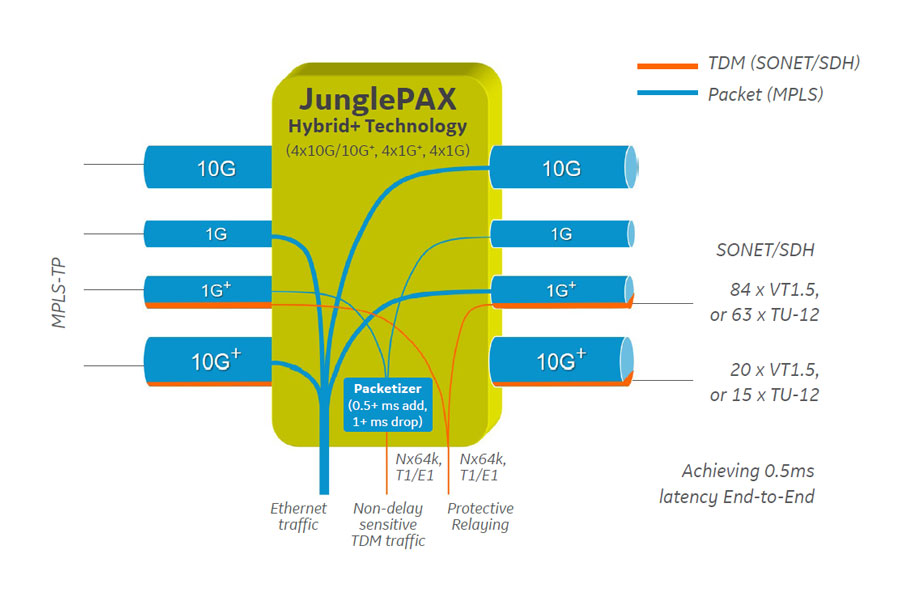
Hybrid+ Technology found only in JunglePAX permits migration from SONET/SDH to Packet-transport technologies without compromising application performance, equipment reliability and network-wide availability.
Modernizing optical communications infrastructure without performance impact
Hybrid+ Technology found only in JunglePAX permits migration from SONET/SDH to Packet-transport technologies without compromising application performance, equipment reliability and network-wide availability.
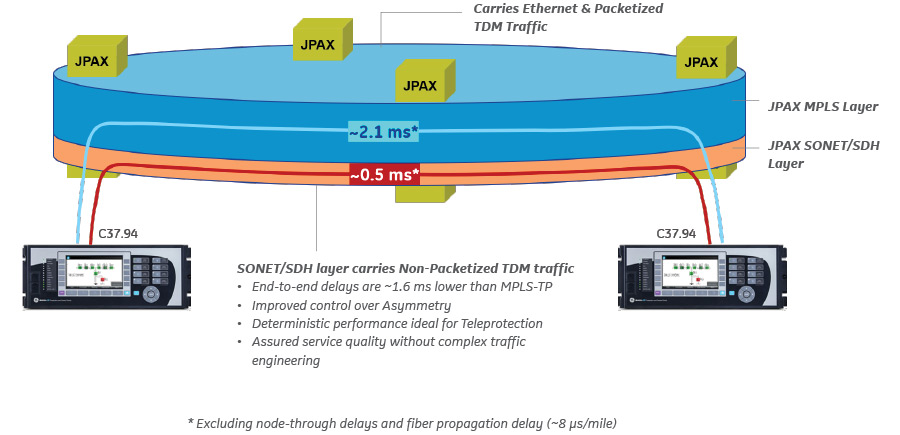
Teleprotection Application
Utilities are concerned about the impact on critical infrastructure and damage or injury associated with a fault condition on the transmission network. Teleprotection is a critical utility application that enables protection devices to communicate in a coordinated, reliable and expeditious way. Distance or directional comparison relays that send tripping signals require deterministic communications with low propagation delay edge (substation) to edge (substation), often as low as within 8ms. The faster the tripping signal can be transmitted across network, the quicker the dangerous energized state can be removed. Due to their importance, tripping signals cannot tolerate network disturbances affecting availability, capacity, physical communication failures, maintenance related outages or security vulnerabilities.
JunglePAX Solution for Teleprotection
The JunglePAX platform has been designed for teleprotection applications with layers of redundancy to ensure there is no single point of weakness, industry leading protection switching within 3ms, and low end-to-end service latency within 1ms excluding propagation delay.
Below is a teleprotection application example, which walks through the sequence of events that the JunglePAX platform would perform to ensure that critical teleprotection circuits are delivered securely and dependably across the network.
Application Defined Networking
The Lentronics JunglePAX is ideal for power utility operations and IT applications, supporting the following typical applications:
Critical Operational Traffic (OT)
- Teleprotection
Essential Operational Traffic (EOT)
- SCADA
- Maintenance & Emergency Voice
- Asset health and status
Critical Information Traffic (CIT)
- Surveillance & Intrusion detection
- Metering
Essential Information Traffic (EIT)
- Business service backhaul
- Connecting field offices and mobile users with operational data
Application Example: Transmission Cable Fault
1 - Transmission cable fault There is a transmission cable fault affecting the primary communication path
2 - Fault detected Fault is detected by the protection relay
3 - Tripping signal A tripping signal is sent to the JunglePAX platform
4 - Fault detected and transmitted The JunglePAX in Substation 1 detects the primary transmission path fault
5 - Teleprotection signal received The JunglePAX in Substation 2 detects the loss of the primary communications path and switches to the protected communications path within 3ms
6 - Protection action Protection relay initiates the action to clear the fault
 JunglePAX provides reliable inter-substation relay communications during primary communications path failures
JunglePAX provides reliable inter-substation relay communications during primary communications path failures
JunglePAX Components
The JunglePAX comprises of replaceable and hot swappable interface cards which ensure that the platform is easy to maintain. The flexible mix of client service cards provides utilities with a solution that addresses changing communications requirements.
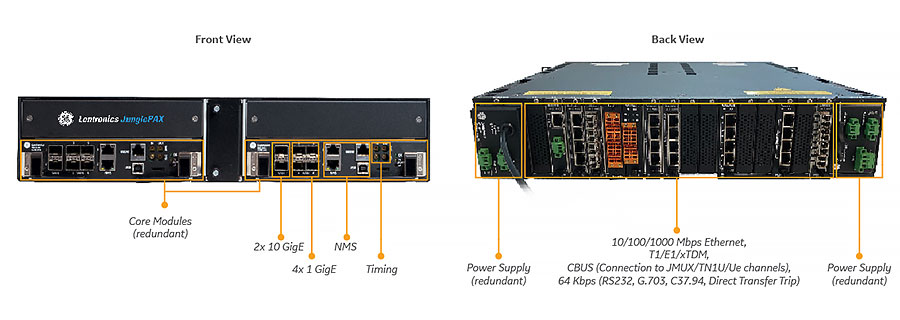
Technical Specifications
| MULTI-SERVICE PLATFORM | |
|---|---|
| Purpose-built, modular in design with layers of redundancy | |
| Hot swap of all redundant components without service interruptions | |
| Utility hardened ensure security and dependability | |
| Non-blocking architecture | |
| WIDE AREA NETWORK (WAN) OPTIONS | ||
|---|---|---|
| Optical WAN | Capacity | 24Gbps |
| Number of 10G Optical WAN ports | 2, SFP+, (up to 80km) | |
| Number of 1G Optical WAN ports | 4, SFP | |
| NETWORK MANAGEMENT | ||
|---|---|---|
| Management | Device management | embedded Management System (eMS) |
| Network management | Optional Advanced NMS | |
| High availability mode | 1+1 protected | |
| Console port | USB | |
| Inbound / Outbound interfaces | CLI, WebUI (HTTPS), SNMPv3 *, NetConf | |
| PERFORMANCE | ||
|---|---|---|
| CORE Hardware protection | 1+1, 20G bypass | |
| Processors | Dual, Dedicated separately for Data (DP) & Management (eM) plane | |
| Transport Protocol | MPLS-TP, RFC 5654 | |
| Encapsulation | WAN-Interface Sublayer (WIS) (on/off) | |
| Quality of service | IEEE 802.1p/q with priority queues and priority scheduling | |
| Node transit delay | < 30 μs | |
| Switching | Capacity | 66G |
| Fabric | Redundant | |
| Backplane | Passive | Yes |
| Client services | TDM and Ethernet | TDM: Emulated TDM over PSN (CESoPSN,SAToP) Ethernet: E-Line, E-Tree and E-LAN Ethernet Virtual Connections, configurable max frame size (up to 12,000 bytes), 32k MAC addresses per node |
| Packetizer | T1/E1/CBUS TDM ports | 8 |
| Synchronization | WAN Synchronization method | SyncE |
| Internal Modes | Headend with SSM, Freerun | |
| Accuracy | 4.6ppm | |
| External modes | 2KHz, 10MHz, 1PPS, GPS * | |
| Quality | SSM, ESMC * | |
| Timing | Timing Protocols | NTP, IEEE 1588v2 (telecom and power) * |
| Accuracy | 1us, Grandmaster (1588v2) * | |
| OAM | Fault Detection | LDI, 256 HW-assisted BFD per CORE |
| Protection Switching | 1+1: <3 ms on fiber break, ~0 ms on CORE module extraction 1:1: <16 ms on fiber break, <50 ms on CORE module extraction | |
| SECURITY | ||
|---|---|---|
| Security | EtherWAN encryption engine | 6 independent encryption engines, Optionally enabled on each WAN port * |
| Encryption | AES 256 | |
| Authentication | SHA 256 | |
| Key distribution | Public/Private, User configurable rolling key frequency * | |
| Access Control | Role-based | |
| User Authentication | RADIUS | |
| Accounting | Syslog (local) | |
| Federal Information Processing Standard | 140-2 | |
| CERTIFICATION | ||
|---|---|---|
| Industry Compliance | SAFETY, UL, EU, CSA | UL 60950-1, ETSI EN/IEC 60950-1, CAN/CSA C22.2, RCM (Australia) |
| Conducted and Radiated emissions | FCC Part 15B, CISPR/EN 55022, EN 300 386, VCCI, AS/NZS CISPR 22, CNS13438, and KN 22 | |
| Immunity | EN 55024, EN 300 386 and KN 24 | |
| Power Substation | IEEE 1613 (no cooling fans) | |
| Hardening | IEEE 1613 (no cooling fans), SWC, EMI, RFI & ESD | |
| Environmental | Operating Temperature | -20°C to + 60°C |
| Storage Temperature | -40°C to +70°C, IEC60068-2 | |
| Humidity, %RH | 5 - 95%, non-condensing | |
| Altitude | 3000m | |
| Earthquake | NEBS ITL GR-63-CORE Issue 4* | |
| RoHS | RoHS / WEEE | |
| POWER MANAGEMENT | ||
|---|---|---|
| Power | DC | 48/130 VDC (ungrounded or +ve grounded), isolated inputs, hot swappable |
| AC | 120/240 VAC, 50/60 Hz, hot swappable | |
| Redundant | Yes | |
| Consumption | 160W, Overcurrent protection at 180W per power supply | |
| ACCESS CARD INTERFACES | ||
|---|---|---|
| Access Card interfaces | Number of Access slots | 16 |
| Hot swappable | Yes | |
| 4 x GigE slots | 3 | |
| EF-4A | 4 x 1G/FE fiber ports, SFP, per-port configurable native VLAN ID | |
| EC-4A | 4 x 10/100/1000 Mbps copper ports, RJ-45, per-port configurable native VLAN ID | |
| GigE slots | 6, using EF-4A and EC-4A units | |
| TDM slots | 4 (16 if xTDM-8A cards are used) | |
| T1E1-4A | 4 x T1/E1 ports, RJ-48c, G.704, G.706, G.826 E1 formats: PCM30/CAS, PCM31/CCS, Unframed | |
| CBUS-4A card | 4x CBUS ports, RJ-48C | |
| xTDM-8A | 8 x T1/E1 ports (G.704, G.706, G.826) or 4 x CBUS ports, RJ-48c * | |
| 64kbps slots | 10 | |
| C3794-1A | 1 x IEEE C37.94, mmf/smf, N x 64 kbps (N=1…12), SFP, LC connector | |
| C3794-4A | 4 x IEEE C37.94, mmf/smf, N x 64 kbps (N=1…12), SFP, LC connector | |
| DR-1A | 1 x RS-232/V.24/V.28 (up to 38.4 kbps) or 1x G.703 64 kbps codirectional | |
| DR-4A | 4 x RS-232/V.24/V.28 (up to 38.4 kbps) or 1 x G.703 64 kbps codirectional | |
| G703D-4A | 4 x G.703 64 kbps codirectional | |
| DTT-2A | 2 x DTT Tx/Rx @48VDC. 130VDC, 250VDC | |
* future release
IT and OT applications have traditionally operated independently over disparate networks, each serving the utility networking groups differently. IT and OT-centric applications can remain separated (i.e., metering from protection) although converged application can share the same space, generating opportunities for utilities to improve OPEX and CAPEX through elimination of redundancy and simplification initiatives.
More components within utility systems are becoming intelligent and requiring new communication connections and functions, generating demand for:
- Real time control in energy delivery support for heterogeneous networks and integration of previously segmented and disparate networks
- Lower utility operational costs through economy of scale, and convergence of operation and information technologies
- A converged network is required, with:
- Increased system capabilities,
- Ability to ensure the performance of critical and time-sensitive applications,
- Simplified and secure technology
GE Vernova and Ribbon Communications have partnered producing an optimized proposition for utilities requiring more from their network. This solution will protect people and critical assets, scaling across the entire communications landscape with information assurance as traffic flows securely across network boundaries.

